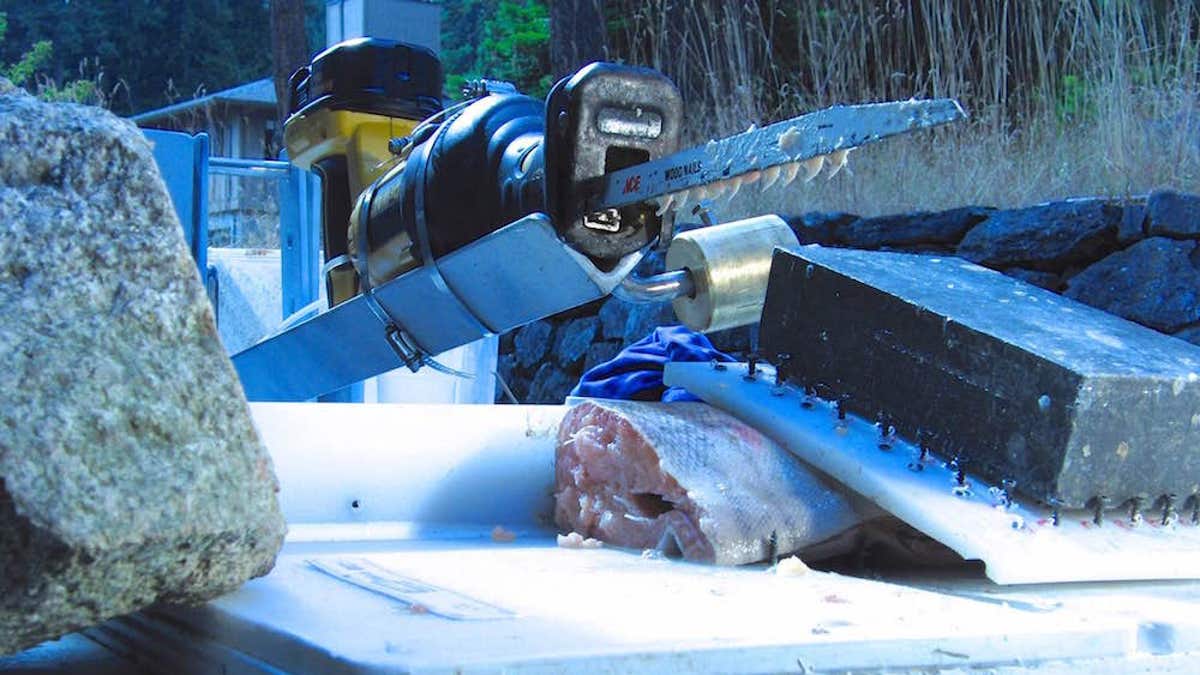
This power saw, poised to cut into a salmon, is armed with shark teeth. (Katherine Corn)
In an experiment fit for a horror movie, researchers glued shark teeth to a power saw and ran them through hunks of raw salmon — all in the name of learning how these ferocious predators attack and devour their prey, a new study reports.
Though unconventional, the "toothy" saw did the trick, and helped the scientists examine the cutting abilities of differently shaped shark teeth.
The sharp teeth of tiger, sandbar and silky sharks dulled quickly, whereas the less sharp teeth of the bluntnose sixgill (Hexanchus griseus) showed less dulling over time, the researchers said. [On the Brink: A Gallery of Wild Sharks]
The findings suggest there may be a trade-off between tooth-cutting ability and wear among sharks, said study co-author Stacy Farina, a postdoctoral fellow of organismal and evolutionary biology at Harvard University.
"Some teeth might be more optimized for cutting [prey] really well, but they wear quickly, " Farina told Live Science. "And some might not cut as well, but they don't wear as quickly."
Most sharks lose and replace their teeth quickly, she noted. It's possible that sharks with sharper teeth actually lose and replace these teeth more frequently than sharks with duller teeth do, she said. But more research is needed to say for sure, because little is known about the rate at which different sharks lose their teeth, Farina said.
Toothy saw
For their experiments, Farina and her colleagues created four saws: one for the bluntnose sixgill, another for the tiger shark (Galeocerdo cuvier), a third saw for the sandbar shark (Carcharhinus plumbeus) and a fourth for the silky shark (C. falciformis).
When sharks hunt, they often rush up to the prey, strike with an open mouth, dig their teeth into the prey and shake their head side-to-side to tear through the prey's body, Farina said.
Related:
Adult sixgills, which eat fish and marine mammals, are not known to display this head-shaking behavior, the researchers wrote in the study. These sharks have teeth that aren't as sharp, perhaps because they eat their prey whole and use their teeth to restrain, rather than to cut, the researchers said. [7 Unanswered Questions About Sharks]
Yet, having duller, longer-lasting teeth may be an advantage: Sixgills live in cold water and have slower metabolisms, and likely don't replace their teeth frequently, meaning they would need the teeth to last longer, Farina said.
The other sharks — the tiger, silky and sandbar — "cut their prey to pieces before eating it, and tiger sharks, in particular, are known to engage with very stiff prey tissues, like the carapace [shell] of sea turtles," the researchers wrote in the study.
To mimic this behavior, study contributor Jeffrey Brash, a metalworker at Valley Steel & Stone in Friday Harbor, Washington, built an apparatus with a fulcrum. This setup allowed the saw to fall onto the salmon carcass, much like a shark would clamp down on its prey, Farina said.
Then, the researchers ran the shark-tooth saws at different speeds to measure their properties, Farina said.
Some experts have questioned the study's methods, however, asking if the transformed saws accurately model a shark attack.
The study reveals interesting facts about the relative mechanical strength of different shark teeth, said John Maisey, a curator of vertebrate paleontology who specializes in fossil fishes at the American Museum of Natural History in New York City and who was not involved with the study.
But, he told Live Science in an email, "I am particularly concerned about the side-to-side motion of the teeth, which (as far as I know) is not something sharks would do; it would require the upper and lower jaws to move sideways relative to each other, whereas most shark jaws generate their cutting action by the vertical 'chomp.'"
The study was published online Aug. 10 in the journal Royal Society Open Science.
Editor's note: This story was updated to say that the researchers didn't run the saws at three different speeds. Rather, they used teeth from three shark genuses. Also, sharks don't hunt with open mouths, but rather rush up to the prey and then strike with an open mouth.
Original article on Live Science. Copyright 2016 LiveScience, a Purch company. All rights reserved. This material may not be published, broadcast, rewritten or redistributed.
